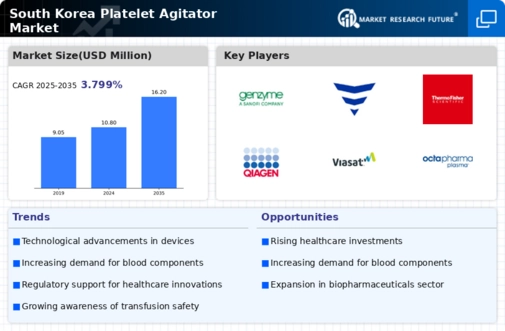Increasing Healthcare Investments
The platelet agitator market in South Korea is experiencing a surge in investments from both public and private healthcare sectors. The government has allocated substantial budgets to enhance healthcare infrastructure, which includes the procurement of advanced medical equipment. In 2025, healthcare spending is projected to reach approximately $200 billion, reflecting a growth rate of around 5% annually. This influx of capital is likely to facilitate the acquisition of sophisticated platelet agitators, thereby improving the efficiency of blood component processing. As hospitals and blood banks upgrade their facilities, the demand for high-quality platelet agitators is expected to rise, driving market growth. Furthermore, the emphasis on improving patient outcomes through better blood management systems may further bolster the platelet agitator market in the region.
Growing Awareness of Blood Donation
In South Korea, there is a notable increase in public awareness regarding the importance of blood donation. Campaigns aimed at educating the population about the necessity of blood components have gained traction, leading to a rise in donations. This heightened awareness is expected to create a corresponding demand for platelet agitators, as blood banks require efficient systems to process and store donated blood. The platelet agitator market is likely to benefit from this trend, as facilities strive to enhance their operational capabilities. With an estimated 3 million blood donations occurring annually, the need for effective blood component management systems becomes paramount. Consequently, the platelet agitator market is poised for growth as blood banks invest in technology to ensure optimal processing and storage of platelets.
Rising Incidence of Hematological Disorders
The increasing prevalence of hematological disorders in South Korea is contributing to the growth of the platelet agitator market. Conditions such as thrombocytopenia and other blood-related diseases necessitate the availability of high-quality platelets for treatment. As the population ages, the incidence of these disorders is likely to rise, leading to a greater demand for platelet transfusions. In 2025, it is estimated that around 1.5 million patients will require platelet transfusions annually, thereby driving the need for efficient platelet processing systems. Blood banks and hospitals are expected to invest in advanced platelet agitators to meet this growing demand, which could result in a market growth rate of approximately 7% over the next few years. This trend underscores the critical role of platelet agitators in ensuring adequate supply for therapeutic needs.
Technological Integration in Blood Processing
The integration of advanced technologies in blood processing is a key driver for the platelet agitator market in South Korea. Innovations such as automation and real-time monitoring systems are being increasingly adopted in blood banks and hospitals. These technologies not only enhance the efficiency of platelet agitation but also ensure compliance with safety standards. The market for platelet agitators is projected to grow by approximately 8% annually as facilities seek to implement these advanced solutions. Moreover, the introduction of smart platelet agitators that can provide data analytics and performance tracking is likely to attract investment. As healthcare providers prioritize operational efficiency and patient safety, the demand for technologically advanced platelet agitators is expected to rise significantly.
Regulatory Support for Blood Component Technologies
The regulatory environment in South Korea is increasingly supportive of advancements in blood component technologies, which positively impacts the platelet agitator market. Regulatory bodies are actively promoting the adoption of innovative medical devices that enhance blood safety and processing efficiency. This support is likely to encourage manufacturers to invest in research and development, leading to the introduction of next-generation platelet agitators. As regulations evolve to accommodate new technologies, the market is expected to witness a growth rate of around 6% annually. Furthermore, compliance with stringent safety standards will drive blood banks to upgrade their equipment, thereby increasing the demand for advanced platelet agitators. This regulatory landscape presents a favorable environment for market expansion, as stakeholders seek to align with best practices in blood management.

















Leave a Comment